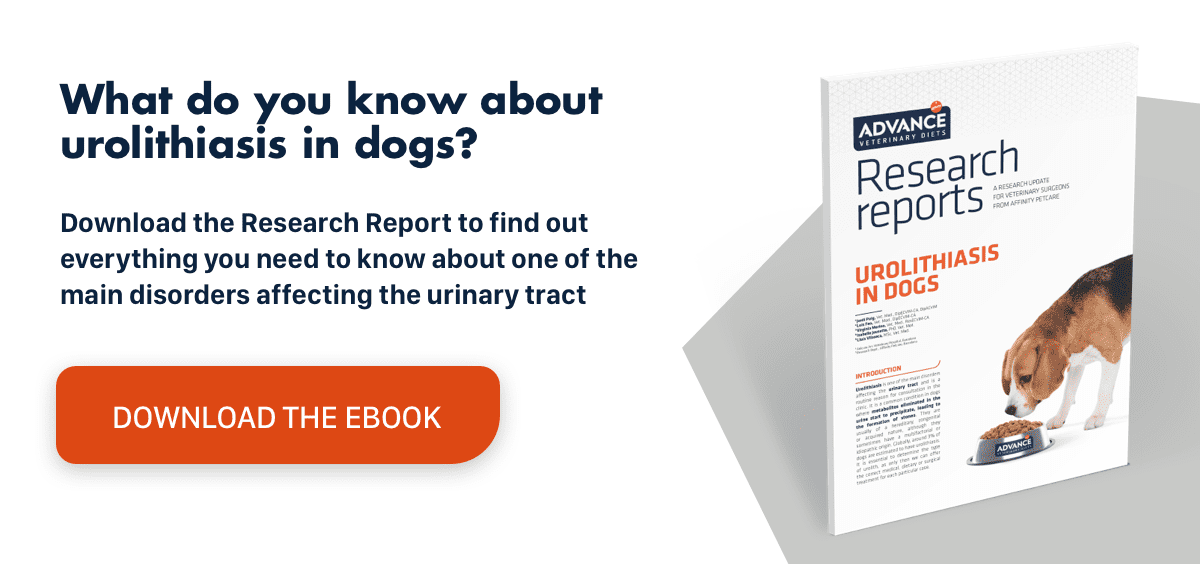Struvite uroliths
1. Infection-induced uroliths
Most struvite uroliths in dogs are caused by a urinary tract infection (UTI) due to a urease-producing bacteria, with the most common microbes being Staphylococcus spp., followed by Proteus spp. and other less common entities, such as Pseudomonas spp.
The urease produced by these bacteria breaks down urea (abundant in the urine) into ammonium and carbon dioxide.
Ammonium combines with magnesium and phosphate in the urine to form magnesium phosphate hexahydrate crystals (struvite). The carbon dioxide increases urine pH and reduces the solubility of struvite crystals. The ammonium also damages the glycosaminoglycan coating of the urothelium which allows struvite crystals and bacteria to adhere to the urinary tract’s lining. Once attached, the struvite crystals aggregate and form uroliths, and bacteria become trapped inside the layers of the growing struvite stone.
2. Sterile struvite uroliths
This type of struvite urolithiasis is rare in dogs, but it does occur. Most struvite stones found in cats, however, are considered sterile and are not the product of a UTI associated with a urease-producing bacteria. Struvite stones arising from an infection are more likely to occur in older cats and kittens.
Senior cats (>10 years) may be more likely to develop infection-induced struvite uroliths because they have a greater risk of developing a UTI compared to young adult cats. No predisposition has been observed based on sex or breed. The mean age of their appearance is 8 years. The exact aetiology of sterile struvite urolithiasis in cats is not well known, but some predisposing factors such as alkaline urine, elevated magnesium and phosphorus levels in urine, highly concentrated urine, family history of struvite stones and distal renal tubular acidosis have been reported.
Along with calcium oxalate uroliths, struvite stones are one of the most common types isolated from cats. Struvite uroliths accounted for 43% of the stones extracted from cats and sent to the Minnesota Urolith Center between 1981 and 2007. Other studies have found a similar incidence. The number of struvite uroliths in cats decreased over a 10-year period (1998–2008) according to a study in Canada. While other laboratories have reported a recent increase in struvite stones collected from cats compared to the 1990s.
CLINICAL SIGNS
Some patients with struvite stones are asymptomatic. Lower urinary tract signs are the most common clinical anomaly. These include haematuria, polyuria, stranguria, urinary incontinence and dysuria. If the struvite urolithiasis causes urethral obstruction, the signs are more serious and may include vomiting, dehydration, lethargy, depression, abdominal pain and arrhythmias.
DIAGNOSIS
Findings from history/physical examination
Some patients with struvite stones are asymptomatic. The most common indications are lower urinary tract signs, such as haematuria, dysuria, polyuria, stranguria and urinary incontinence. Sometimes the stones are located in the urethra and can cause urethral obstruction, leading to more serious disorders, such as vomiting, abdominal pain, dehydration, depression, cardiac arrhythmias and collapse.
URINALYSIS
Struvite crystals have a so-called coffin lid appearance. Struvite crystalluria is commonly present with struvite urolithiasis. However, up to 50% of urine samples from healthy dogs may contain struvite crystals, so the presence of struvite crystals does not necessarily indicate there are struvite stones.
Struvite crystals can also form after sample collection, once the urine has cooled below body temperature. Struvite crystals tend to form in alkaline urine. Other potential alterations in the urinalysis include haematuria, proteinuria, pyuria and bacteriuria.
Since most struvite uroliths in dogs and some in cats are infection induced, a urine culture is recommended.
ABDOMINAL X-RAY/ULTRASOUND:
Struvite stones are moderately to markedly radiopaque, may exist as single or multiple stones and are usually found in the bladder and urethra. They are rarely found in the ureter or renal pelvis. Small struvite uroliths may not be detected on screening X-rays.
The rate of failure to detect uroliths on screening X-rays ranges from 2% to 27%. An abdominal contrast X-ray or ultrasound may help identify some stones.
Cystoscopy: Cystoscopy can be used to find struvite uroliths in the lower urinary tract.
UROLITH MINERAL ANALYSIS:
A quantitative mineral analysis will confirm the composition of stones once extracted. Uroliths should not be placed in formalin when sent to the laboratory, as this may lead to a misinterpretation of the mineral composition.
UROLITH CULTURE:
Uroliths extracted at the time of surgery can be cultured, especially if the urine culture was negative. In one study, 18% of cases with negative urine cultures had positive urolith cultures. The nucleus of the urolith or the liquid used to flush the urolith can be cultured 1–4 times.
DIFFERENTIAL DIAGNOSIS
Bacterial cystitis, feline idiopathic cystitis
Other types of urolith: calcium oxalate, cystine, silica, urate, xanthine, dried solidified blood
Urethritis
Bladder or urethral tumour
Urinary tract injuries

